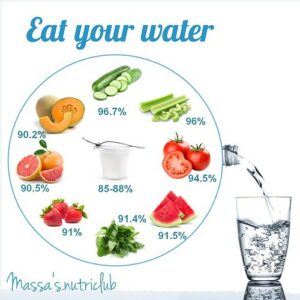Foods That Hydrate
go.ncsu.edu/readext?883455
en Español / em Português
El inglés es el idioma de control de esta página. En la medida en que haya algún conflicto entre la traducción al inglés y la traducción, el inglés prevalece.
Al hacer clic en el enlace de traducción se activa un servicio de traducción gratuito para convertir la página al español. Al igual que con cualquier traducción por Internet, la conversión no es sensible al contexto y puede que no traduzca el texto en su significado original. NC State Extension no garantiza la exactitud del texto traducido. Por favor, tenga en cuenta que algunas aplicaciones y/o servicios pueden no funcionar como se espera cuando se traducen.
Português
Inglês é o idioma de controle desta página. Na medida que haja algum conflito entre o texto original em Inglês e a tradução, o Inglês prevalece.
Ao clicar no link de tradução, um serviço gratuito de tradução será ativado para converter a página para o Português. Como em qualquer tradução pela internet, a conversão não é sensivel ao contexto e pode não ocorrer a tradução para o significado orginal. O serviço de Extensão da Carolina do Norte (NC State Extension) não garante a exatidão do texto traduzido. Por favor, observe que algumas funções ou serviços podem não funcionar como esperado após a tradução.
English
English is the controlling language of this page. To the extent there is any conflict between the English text and the translation, English controls.
Clicking on the translation link activates a free translation service to convert the page to Spanish. As with any Internet translation, the conversion is not context-sensitive and may not translate the text to its original meaning. NC State Extension does not guarantee the accuracy of the translated text. Please note that some applications and/or services may not function as expected when translated.
Collapse ▲The soaring temperatures have been extreme lately even for summer in the south. The temperature plus humidity can easily send the heat index into dangerous levels and make staying cool very difficult.
As our bodies perspire, the fluid that is excreted through the skin acts as a cooling agent to regulate body temperature to within normal, healthy ranges. Even though our body has a natural way of cooling itself, it can do this only if we provide the fluid needed. When too little fluid is consumed and/or too much is lost, fluid levels fall below normal, resulting in dehydration. Some symptoms of dehydration, such as increased body temperature and pulse rate, can occur without our being totally aware of them. We may even brush off a slight headache or fatigue without connecting it to dehydration. By the time we experience other symptoms like dizziness and weakness, we could be in real trouble.
Water aids the body in performing numerous vital functions. In addition to regulating body temperature, water helps with digestion and absorption of nutrients, flushes out waste, improves respiration, and lubricates joints. Water makes up 75 percent of your brain, 75 percent of your muscles, and 83 percent of your blood. So when the body becomes dehydrated, it affects how you feel and your ability to move and think. Confusion or feeling disoriented is a common symptom of dehydration.
Heat-induced illnesses include heat cramps, heat exhaustion, and the more severe heat stroke. Heat cramps are usually the result of hard physical labor in a hot environment, often resulting from an imbalance of electrolytes in the body. Heat exhaustion is a result of the combination of excessive heat and dehydration, and left untreated, can lead to heat stroke. Heat stroke is the most serious disorder associated with heat stress. It occurs when the body’s temperature regulation fails and body temperature rises to critical levels. It is a medical emergency that can lead to death.
Anyone can be at risk of experiencing dehydration or heat-related illness. Age, weight, degree of physical fitness, metabolism, use of alcohol or medications, and a variety of medical conditions all affect a person’s sensitivity to heat. Babies and children younger than 4 have underdeveloped body systems and can’t regulate body temperature as efficiently. Adults over 65 may not be able to regulate temperature as well because of medications, illness, or other factors. Medications used to treat high blood pressure, heart problems, allergies, depression, and other conditions can affect your body’s ability to stay hydrated and efficiently cool itself. Excess weight raises your core body temperature and makes it harder for your body to regulate your temperature.
Drinking water and consuming foods with high water content are the best ways to stay hydrated. People get about 80 percent of their necessary water intake from beverages. The other 20 percent comes from food. Fruits, in general, have high water content with melons, peaches, pineapple, berries, apples, and oranges topping the list. Vegetables such as squash, corn, celery, romaine lettuce, cucumbers, and tomatoes are great sources of water as well. Foods that we make by adding water or milk count too, like Jell-o, popsicles, and cereal. Summer may be too hot for your favorite soup, but cold soups can be refreshing and hydrating. A chilled peach soup or a cold vegetable soup like Gazpacho are delicious and nutritious ways to increase water intake.
There are three basic steps to preventing heat-related illness. Wear lightweight, light-colored, loose-fitting clothing that allows good air flow. Avoid outdoor activities during the hottest part of the day when possible. Stay hydrated by taking in plenty of fluids from non-caffeinated beverages and cool, light foods.





